Improving Lives: Helping Workless Families indicators 2023: Data for 2005 to 2022
Published 23 March 2023
What you need to know
There are 9 indicators and underlying measures used to track national progress in tackling the disadvantages that affect families and children’s outcomes:
1. Parental Worklessness
2. Parental Conflict
3. Poor Parental Mental Health
4. Parental Drug and Alcohol Dependency
5. Problem Debt
6. Homelessness
7. Early Years
8. Educational Attainment
9. Youth Employment
The government has a statutory duty to report data annually to Parliament on 2 of the 9 indicators for England only:
1. Parental Worklessness
a. The proportion of children living in workless households
b. The proportion of children living in long-term workless households
2. Educational attainment at Key Stage 4
Read the annual update on these indicators.
Contact Details
helpingworklessfamilies@dwp.gov.uk
Media enquiries: contact DWP Press Office
Feedback is welcome.
Indicator 1: Parental Worklessness
Workless households are households where no one aged 16 years or over is in employment. These members may be unemployed or economically inactive. Economically inactive members may be unavailable to work because of family commitments, retirement, study, sickness or disability.
A long-term workless household is a workless household, as defined above, that has been workless for at least 12 months or has never worked (in a paid job). A long-term workless household does not necessarily imply that adults within them have been long-term unemployed. Some adults may have been out of work for 12 months or more but had periods of inactivity such as looking after family or illness during that time.
10% of all children were living in workless households between October and December 2022
Proportion of children living in workless households (UK), 2006 to 2022
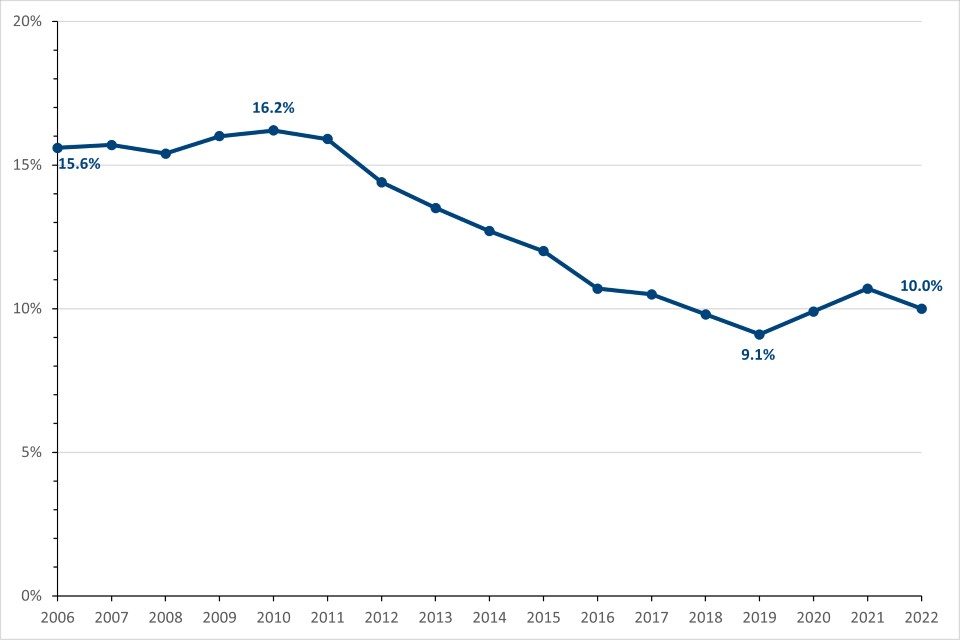
Data: Table 1a
Source: Working and workless households in the UK: October to December 2022
10% of all children (around 1.28 million children) were living in workless households in the fourth quarter of 2022. This has decreased by approximately 84,000 children from the previous year.
The percentage of children in workless households is derived from the Labour Force Survey (LFS), which samples around 75,000 people each quarter. To avoid seasonal fluctuations in quarter-on-quarter data results from October to December are compared each year.
Proportion of children living in long-term workless households (UK), 2006 to 2021
8.9% of all children were living in workless households for at least 12 months in 2021
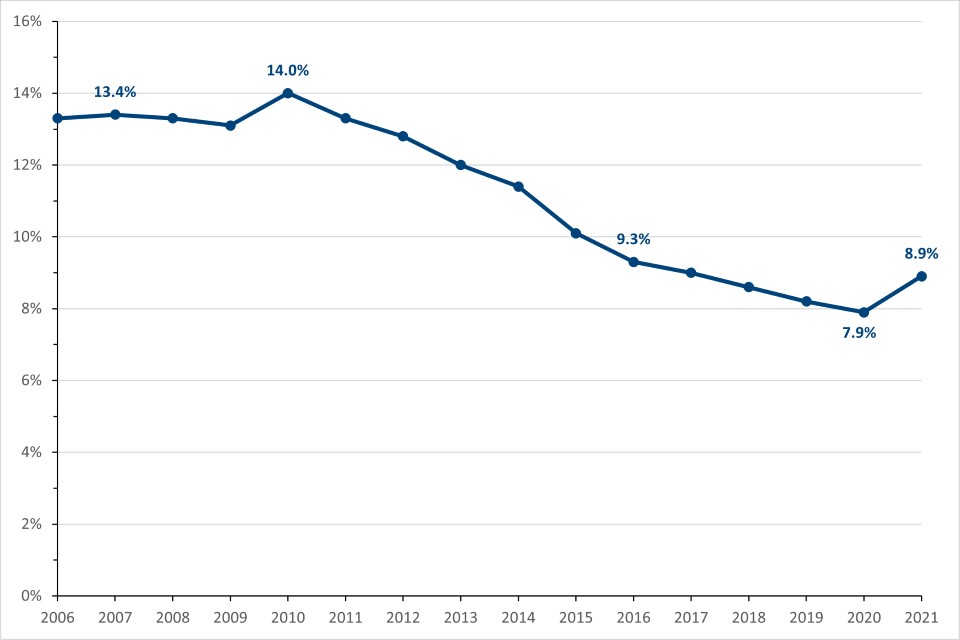
Data: Table 1b.
Source: Children living in long-term workless households in the UK: 2021
8.9% of all children (around 1.1 million children) were living in long-term workless households in 2021. This has increased by approximately 134,000 children from the previous year.
The percentage of children in long-term workless households is from the Annual Population Survey (APS) that combines Waves one and 5 of the LFS with an additional booster sampler and contains around 300,000 individuals.
For more information:
Working and workless households in the UK: October to December 2022
Children living in long-term workless households in the UK: 2021
Indicator 2: Parental Conflict
The proportion of children in couple-parent families reporting relationship distress has not been updated as the Understanding Society survey data for the measure is updated every two years. The next update will be in 2024.
The parental conflict measures have been developed using Understanding Society survey data. The Understanding Society survey interviews up to 40,000 households across the UK each year. Households are asked questions relating to relationship distress once every 2 years.
Experiencing relationship distress is defined here as when either parent in a couple-parent family states that most or all of the time they consider divorce, regret living together, quarrel, or get on each other’s nerves (in response to questions asking about their relationship with their partner).
Regular contact with the non-resident parent is defined as when the resident parent states that the child ‘usually sees’ the non-resident parent ‘at least fortnightly’ during term time. Regular contact between children and their parents is a positive outcome and serves as a proxy measure for reasonable quality inter-parental relationships in separated families.
12% of children in couple-parent families were living with at least one parent reporting relationship distress in 2019/20
52% of children in separated families saw their non-resident parent at least fortnightly in 2019 to 2020
Proportion of children in couple-parent families reporting relationship distress (UK), 2011 to 2020
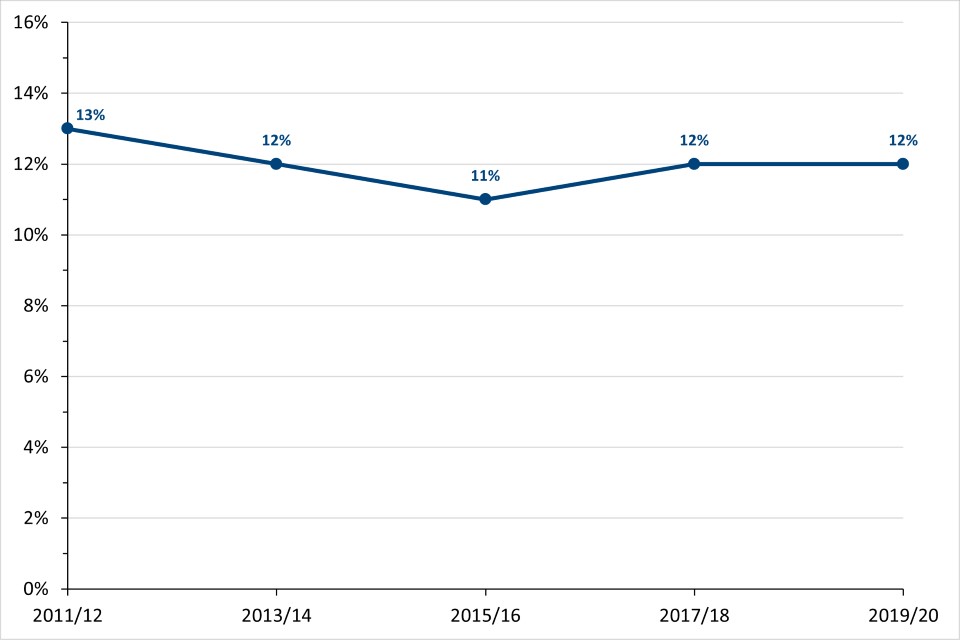
Data: Table 2a.
Source: Parental conflict indicator 2011 to 2020.
Proportion of children living in separated families who see their non-resident parent regularly (UK), 2013 to 2020
| Year | Proportion of children who see their non-resident parent regularly (%) |
|---|---|
| 2013 to 2014 | 53% |
| 2015 to 2016 | 52% |
| 2019 to 2020 | 52% |
Data: Table 2b.
Source: Parental conflict indicator 2011 to 2020.
For more information:
Parental conflict indicator 2011 to 2020
Indicator 3: Poor Parental Mental Health
The proportion of children living with at least one parent reporting symptoms of anxiety and/or depression has not been updated in 2023. This indicator will be updated in 2024 subject to a review of the underlying data.
Poor Parental Mental Health is measured using the Understanding Society survey, which captures information from up to 40,000 households across the UK each year. The questions come from the 12-item General Health Questionnaire (GHQ-12), which is the most widely used screening tool for common mental disorders.
Twelve questions are asked about an individual’s self-confidence, worries and sleep amongst other things over the past few weeks. The questions have two negative options (where the respondent feels worse than usual) and two positive options (where the respondent feels the same or better than usual). Scores of one are given to negative responses and zero to positive responses. Scoring four or more classifies the person as reporting symptoms of anxiety or depression.
This is considered a better measure of poor mental health than asking the respondent if they have been diagnosed with depression or anxiety, as asking the respondent directly is likely to under-represent the level of poor mental health due to under-diagnosis and under-reporting.
The most recent data show that the proportion of children living with at least one parent reporting symptoms of emotional distress has increased each year from 2014/15.
The proportion of children living with at least one parent reporting symptoms of emotional distress was 34%
Proportion of children living with at least one parent reporting symptoms of anxiety and/or depression (UK), 2010 to 2020

Data: Table 3a.
Source: Children living with parents in emotional distress: March 2022 update
For more information:
Children living with parents in emotional distress: March 2022 update
Indicator 4: Parental Drug and Alcohol Dependency
The number of parents who are opiate users or dependent on alcohol has not been updated for 2019/20, as new data are not available. Parents are defined as individuals aged 18 and over that have children (aged under 18) living with them. Parents involved in treatment also includes pregnant individuals.
In 2018/19 around 121,000 parents were estimated to be dependent on alcohol in England
The number of parents who are opiate users or dependent on alcohol (England), 2010 to 2019
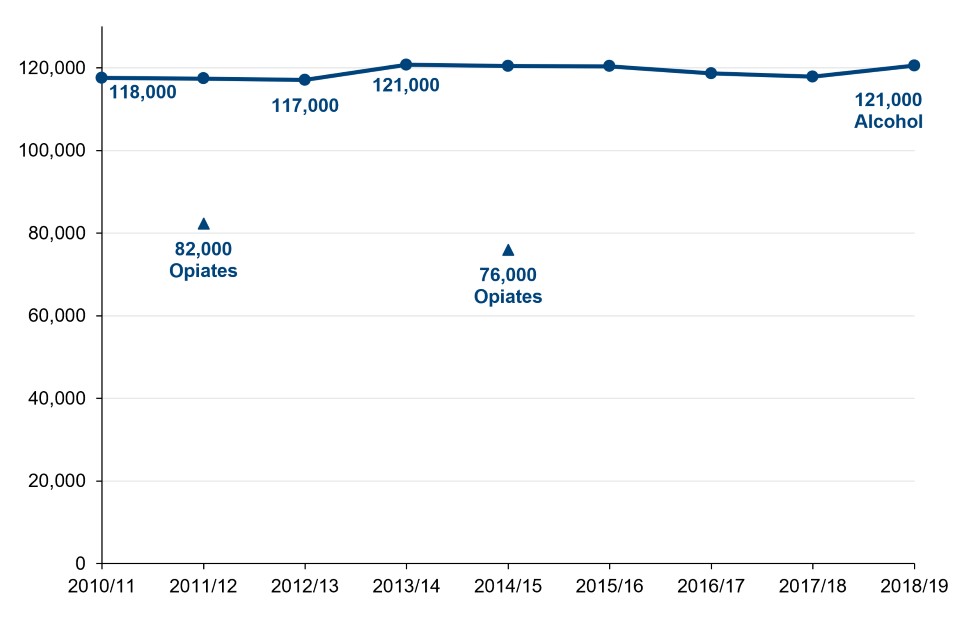
Data: Table 4a.
Between 2010/11 and 2018/19, the number of alcohol-dependent parents has remained largely stable. It increased from 118,000 in 2017/18 to 121,000 in 2018/19.
Alcohol dependency is estimated using data from the Adult Psychiatric Morbidity Study (APMS), Office for National Statistics census information and hospital admissions by Sheffield University and Public Health England. Opiate dependency uses data from the Police National Computer, probation and prison treatment data and data from the National Drug Treatment Monitoring System. They are produced by Liverpool John Moores University and Manchester University with support from Public Health England.
Between 2019 and 2022, 51% of parents with alcohol dependency and 16% of opiate using parents completed treatment and did not return within 3 years
Proportion of alcohol dependent or opiate using parents who have entered and completed treatment within the last three years (England), 2008 to 2022

Data: Table 4b.
The proportion of alcohol-dependent parents completing treatment rose to 51% between 2019/22. The percentage of parents completing treatment for opiate use also increased to 16% between 2019/22. Both measures have risen by one percentage point since 2018/21.
The proportion of alcohol-dependent or opiate using parents completing treatment uses information collected through the National Drug Treatment Monitoring System analysed by Public Health England. It counts parents who have completed and not returned for treatment within three years. Opiate users must not be receiving any substitute medication at the time of leaving treatment.
For more information:
Substance misuse treatment for adults: statistics 2018 to 2019
Indicator 5: Problem Debt
The proportion of children living in households in persistent problem debt has not been updated in 2022. The data are from the Wealth and Assets survey and is due to be published later in 2023. The next update will be in 2024.
A household is considered as being in problem debt if at least one adult:
- reports falling behind with bills or credit commitments and the household’s debt repayments are at least 25% of the household’s net monthly income
- reports falling behind with bills or credit commitments and at least one adult is currently in two or more consecutive months’ arrears on bills or credit commitments
- considers debt a heavy burden and the household’s debt represents at least 20% of the household’s net annual income
Persistent problem debt is where children are in a household in problem debt in two consecutive waves of the Wealth and Assets Survey (WAS).
1.6% (around 195,000) of all children in Great Britain were living in households in persistent problem debt
Proportion of all children living in households in persistent problem debt (Great Britain), 2010 to 2020
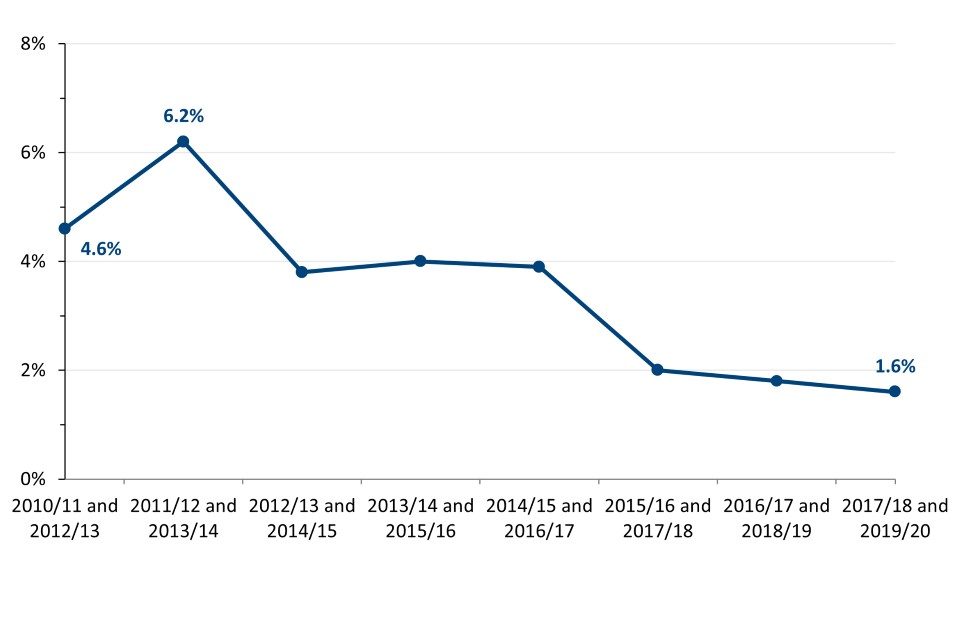
Data: Table 5a.
Source: Problem debt, Great Britain: July 2010 to June 2016 and April 2014 to March 2020
The proportion of children living in households in persistent problem debt fell to 1.6% from 1.8% in the most recent 2-year period. It is well below its peak of 6.2% in 2011/12 and 2013/14.
Proportion of all children living in households in problem debt (Great Britain), 2010 to 2020
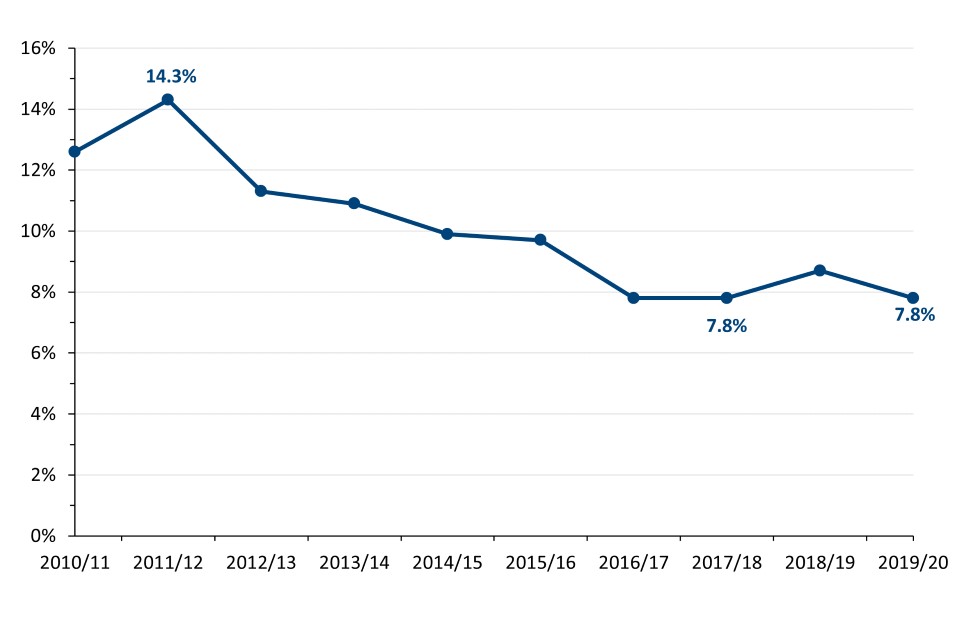
Data: Table 5b.
Source: Wealth and Assets Survey (Great Britain)
The proportion of children living in households in problem debt is not part of the Problem Debt Indicator but provides evidence to support the measure.
7.8% of children were living in households in problem debt in 2019/20.
For more information:
Problem debt, Great Britain: July 2010 to June 2016 and April 2014 to March 2020
Indicator 6: Homelessness
The term ‘homelessness’ does not only apply to people ‘sleeping rough’. For this indicator, homelessness is statutory homelessness, where a local authority has accepted a homeless duty for a household.
A homelessness duty is where a local authority is satisfied that the household is unintentionally homeless, eligible for assistance and is in a specified priority need group for example they have dependent children. Suitable accommodation must be made available by the local authority when there is a homelessness duty. This can involve placing the household in temporary accommodation until a settled housing solution becomes available or until some other circumstance ends the duty.
Around 8 in every 1,000 households in England with dependent children (59,500 households) were living in temporary accommodation at the end of June 2022
Households with dependent children living in temporary accommodation per 1,000 households (England), 2005 to 2022
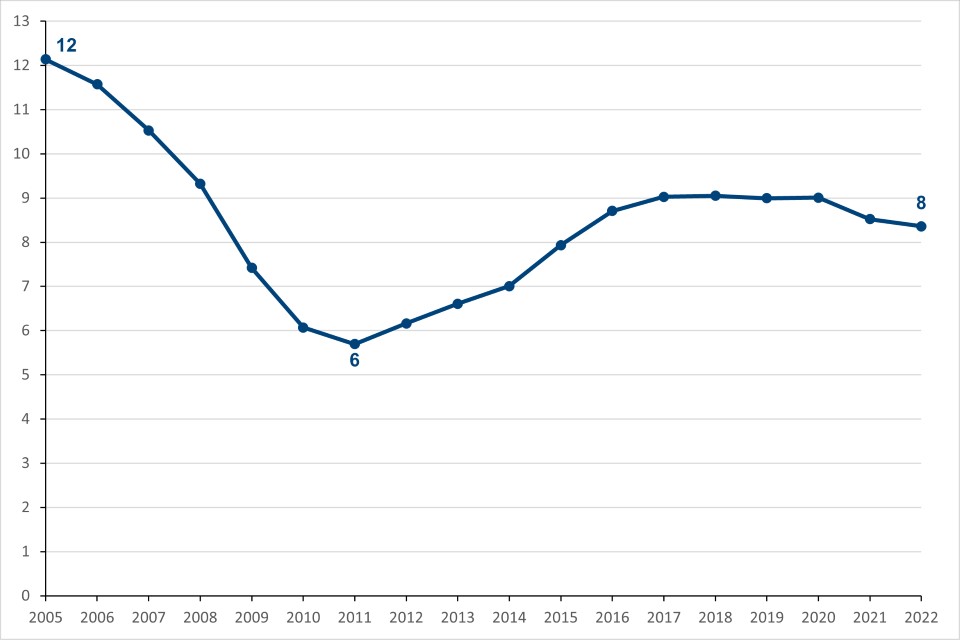
Data: Table 6a.
Source: Department for Levelling Up, Housing and Communities, Homelessness Statistics and Household Projections
8 in every 1,000 (59,500) households were living in temporary accommodation with children at the end of June 2022. This value is rounded to the nearest whole number; the unrounded number of households living in temporary accommodation with children at the end of June 2021 was 8.36. This is below the peak of 12 in every 1,000 (73,000) households at the end of June 2005.
The number of households with dependent children living in temporary accommodation per 1,000 households combines statistics on dependent children in temporary accommodation and projections of the number of households with dependent children from the Department for Levelling Up, Housing and Communities. Information on the number of households in temporary accommodation is collected from local authorities on the last day of each quarter.
For more information:
2014-based household projections: detailed data for modelling and analytical purposes
Indicator 7: Early Years
The early years foundation stage profile (EYFSP) assesses the development of children in state-funded early years education at the end of the academic year in which they turn five. This is typically the summer term of reception year. Teachers assess children’s development through classroom observations against 17 early learning goals (ELGs) across 7 areas of learning. Children are considered to have a good level of development when at the expected level in the 12 ELGs within the 5 areas of learning relating to: communication and language; personal, social and emotional development; physical development; literacy; and mathematics.
The EYFSP was revised significantly in September 2021. Changes from the previous framework included strengthening all 7 areas of learning, making the 17 ELGs clearer and more precise, and removal of the ‘exceeding’ assessment band and statutory local authority moderation. It is therefore not possible to directly compare 2021/22 assessment outcomes with earlier years.
49% of children eligible for free school meals in 2021/22 had a good level of development
Percentage of children with a good level of development by free school meals eligibility (England), 2012/13 to 2021/22
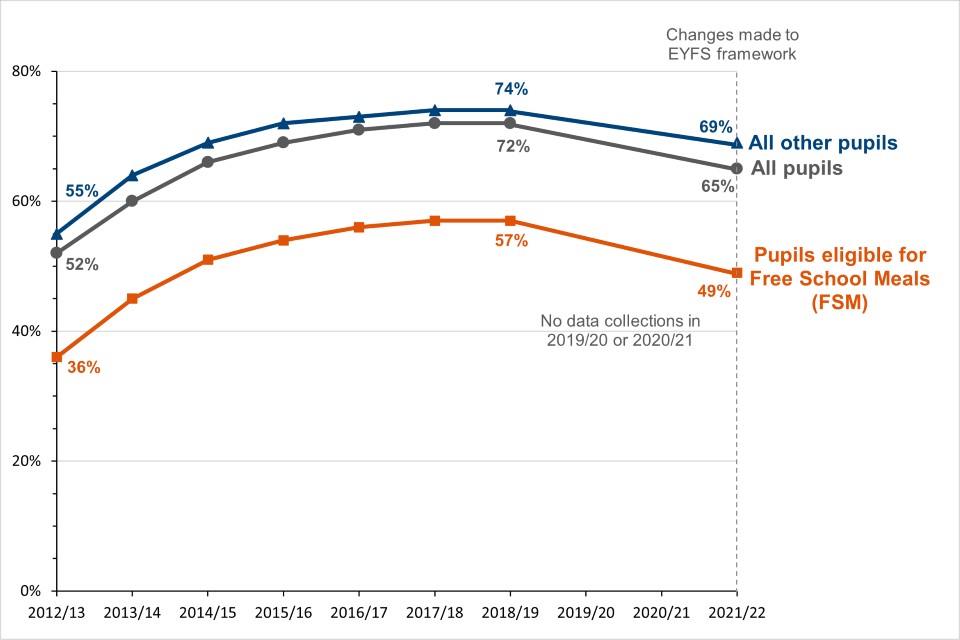
Data: Table 7a
Source: Early years’ foundation stage profile results: 2021 to 2022
In 2021/22, 49% of children eligible for free school meals had a good level of development at the end of reception year, compared to 69% of all other children and 65% of all children.
Differences in good level of development between children eligible for free school meals and all other children (England), 2012/13 to 2021/22
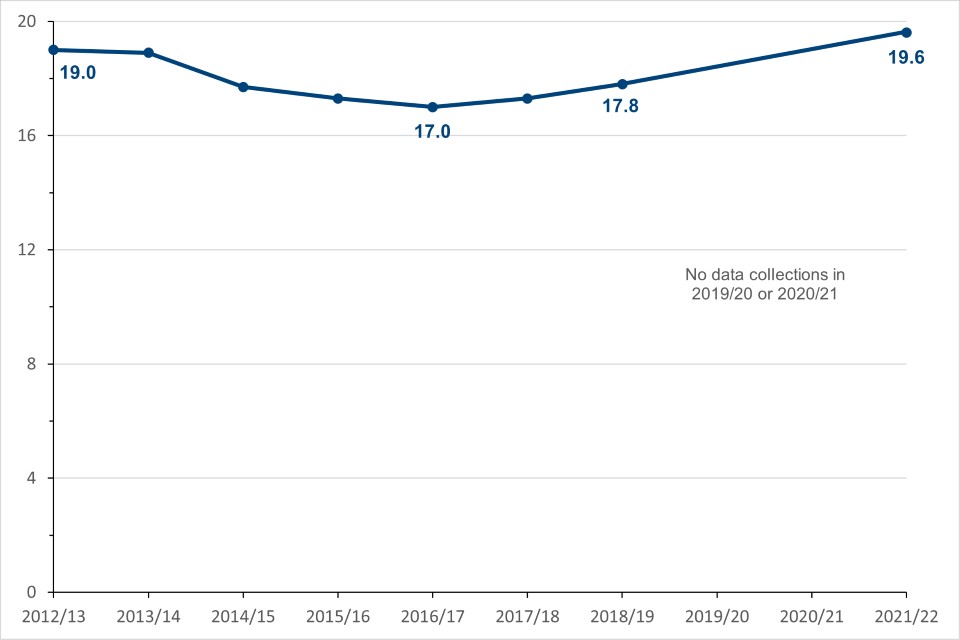
Data: Table 7b
Source: Early years’ foundation stage profile results: 2021 to 2022
In 2021/22, the percentage of children with a good level of development was 19.6 percentage points lower for children eligible for free school meals than for all other children. Though not directly comparable because of reforms to the EYFSP, the 2018/19 figure was 17.8 percentage points.
For more information:
Early years’ foundation stage profile results in England: 2021/22
Indicator 8: Educational Attainment
30% of pupils at the end of Key Stage 2 in 2022 and 26% of pupils at the end of Key Stage 4 in 2022 were classified as disadvantaged in state funded schools. Pupils are defined as disadvantaged if they have been eligible for free school meals in the previous six years, they have been looked after for at least one day during the year or they have ceased to be looked after by a local authority in England because of adoption, a special guardianship order, a child arrangements order or a residence order.
For this indicator, we define attainment at Key Stage 2 as the proportion of pupils reaching the expected standard in reading, writing and maths.
Attainment at Key Stage 2 (England), 2016 to 2022
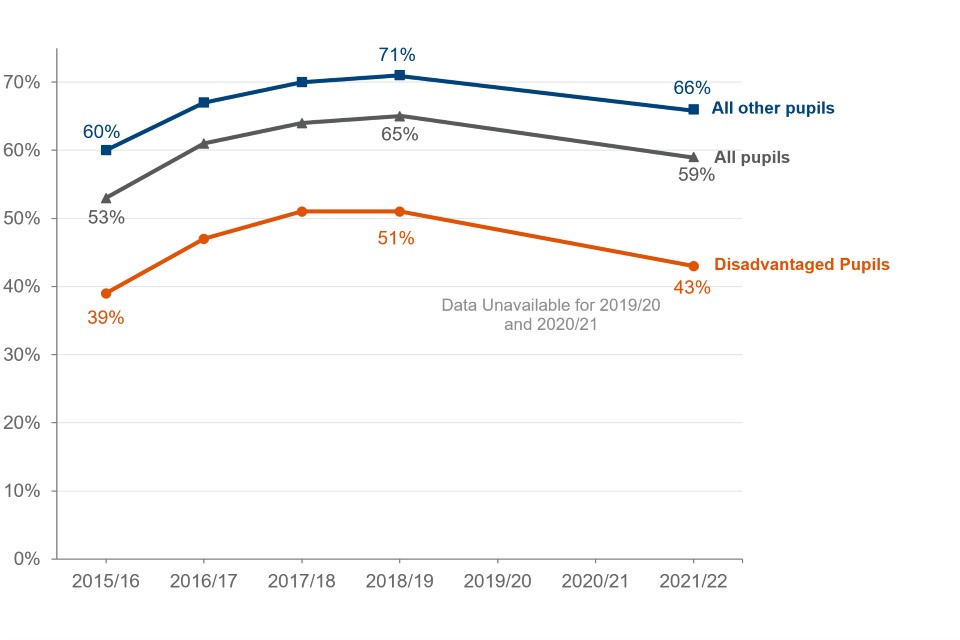
Data: Table 8a.
The impact of the COVID-19 pandemic meant that Key Stage 2 tests and assessments did not take place in the 2019/20, or 2020/21 academic years.
There has been a decline in performance across all measures since the completion of the 2018/19 Key Stage 2 examinations. In 2021/22, 43% of disadvantaged pupils achieved the expected standard in reading, writing, and maths. This compares to 66% of non-disadvantaged pupils and 59% of all pupils. It is particularly notable that the attainment level of pupils from disadvantaged backgrounds have experienced the most significant decrease.
Attainment at Key Stage 4 (England), 2016 to 2022
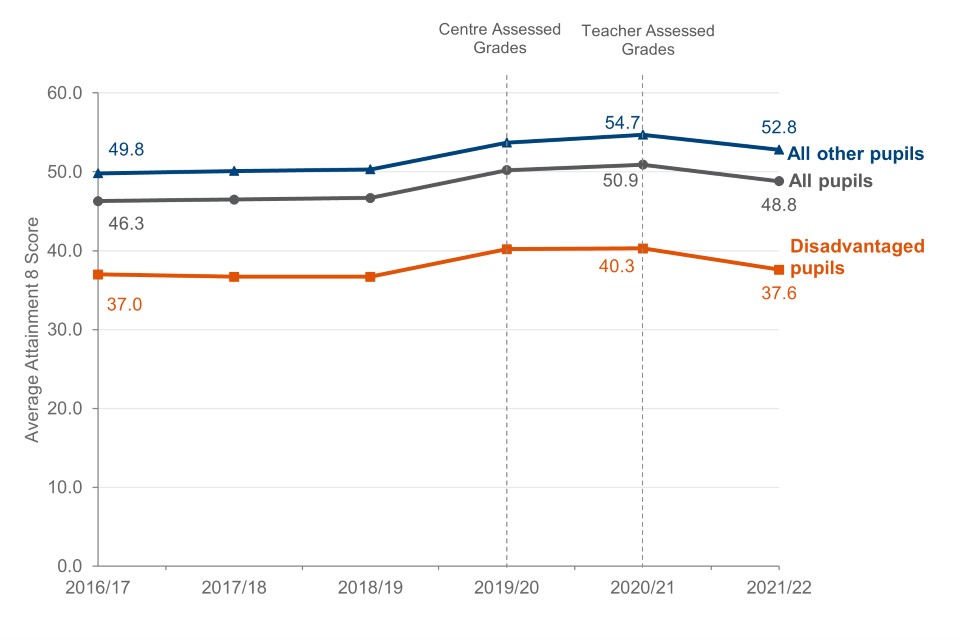
Data: Table 8b.
Source: Key Stage 4 performance 2022
In 2021/22, the average attainment 8 score for disadvantaged pupils was 37.6. Comparatively, the average attainment 8 score of non-disadvantaged pupils was 52.8.
The summer exam series was cancelled in both 2019/20 and 2020/21 due to the impact of the COVID-19 pandemic, where alternative assessed processes were set up to award grades. In 2019/20 pupils scheduled to sit GCSE level exams were awarded the higher grade of either their:
- centre assessment grade (based on what the school or college believe the student would have most likely have achieved
- calculated grade estimated from a model developed by Ofqual
For 2020/21, pupils were assessed only on content they had been taught for each course. Schools were given flexibility to decide how to assess their pupils’ performance, for example, through mock exams, class tests, and non-exam assessment already completed. GCSE grades were then determined by teachers based on the range of evidence available and they are referred to as teacher-assessed grades.
For 2021/22, as part of the transition back to the summer exam series, adaptations were made to the exams (including provision of information in advance) and the approach to grading for 2022 exams broadly reflected a midpoint between approaches in 2019 and 2021.
For more information on changes to 2021/22 measures: Secondary accountability measures (including Progress 8 and Attainment 8).
The Disadvantage Attainment Gap Index at Key Stage 2 and 4 (England), 2010/11 to 2021/22
The disadvantage attainment gap at Key Stage 2 was 3.23 in 2021/22, which has risen from the last recorded result of 2.9 in 2018/19.
The disadvantage attainment gap at Key Stage 4 was 3.84 in 2021/22 which has risen from 3.79 in 2020/21.

Data: Table 8c.
Source: National curriculum assessments: key stage 2, 2022 (revised) and Key Stage 4 performance
The Disadvantage Attainment Gap Index for Key Stage 2 and 4 is not part of the Educational Attainment indicator but provides evidence to support the measures. It shows if disadvantaged pupils are catching up or getting left behind. A disadvantage gap of zero would indicate that pupils from disadvantaged backgrounds perform as well as pupils from non-disadvantaged backgrounds. The maximum possible gap is 10 (or -10 if disadvantaged pupils perform better than other pupils).
The gap index is more resilient to changes to grading systems and assessment methods. Whilst the absolute differences (in English and Maths GCSE grades) may differ between years, the gap index measures how disadvantaged pupils compare to non-disadvantaged pupils and therefore, offers greater comparability between years.
For more information:
National curriculum assessments: key stage 2, 2021/22 (revised)
Indicator 9: Youth Employment
11.5% of young people (aged 16 to 24) who are not in education, employment or training (NEET) (UK), 2007 to 2022

Data: Table 9a.
Source: Young people not in education, employment or training (NEET), UK: February 2023
The proportion of young people (aged 16 to 24) who are NEET in October to December 2022 was 11.5%, this has increased by 1.3 percentage points since last year. This is 5.4 percentage points lower than the peak of 16.9% in July to September 2011. The data are is from the Labour Force Survey (LFS) which samples around 75,000 people each quarter and the estimates are seasonally adjusted.
5.4% of young people aged 18 to 24 have not been in employment or full-time education for two years
Proportion of young people aged 18 to 24 who have not been in employment or full-time education for two years or more (UK), 2006 to 2021
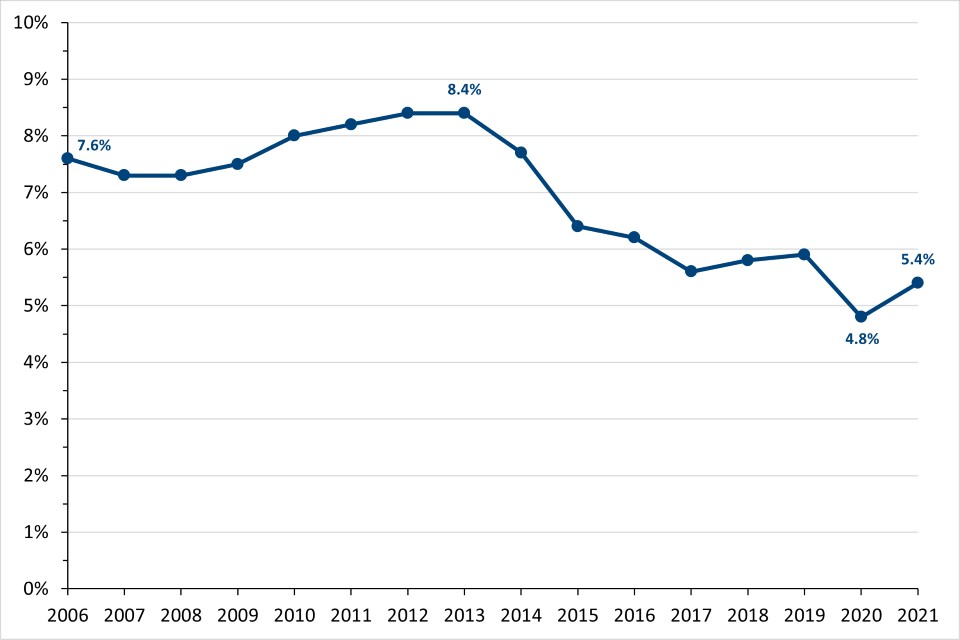
Data: Table 9b
Source: Young people who are long-term workless
The proportion of young people (aged 18 to 24) who have not been in employment or full-time education for two years has risen to 5.4% in 2021.
The data are from the Annual Population Survey (APS) that combines Waves one and five of the LFS with an additional booster sampler and contains around 300,000 individuals. A 2-year threshold is used to eliminate those voluntarily spending time out of the labour market, for example those on a gap year.
For more information:
